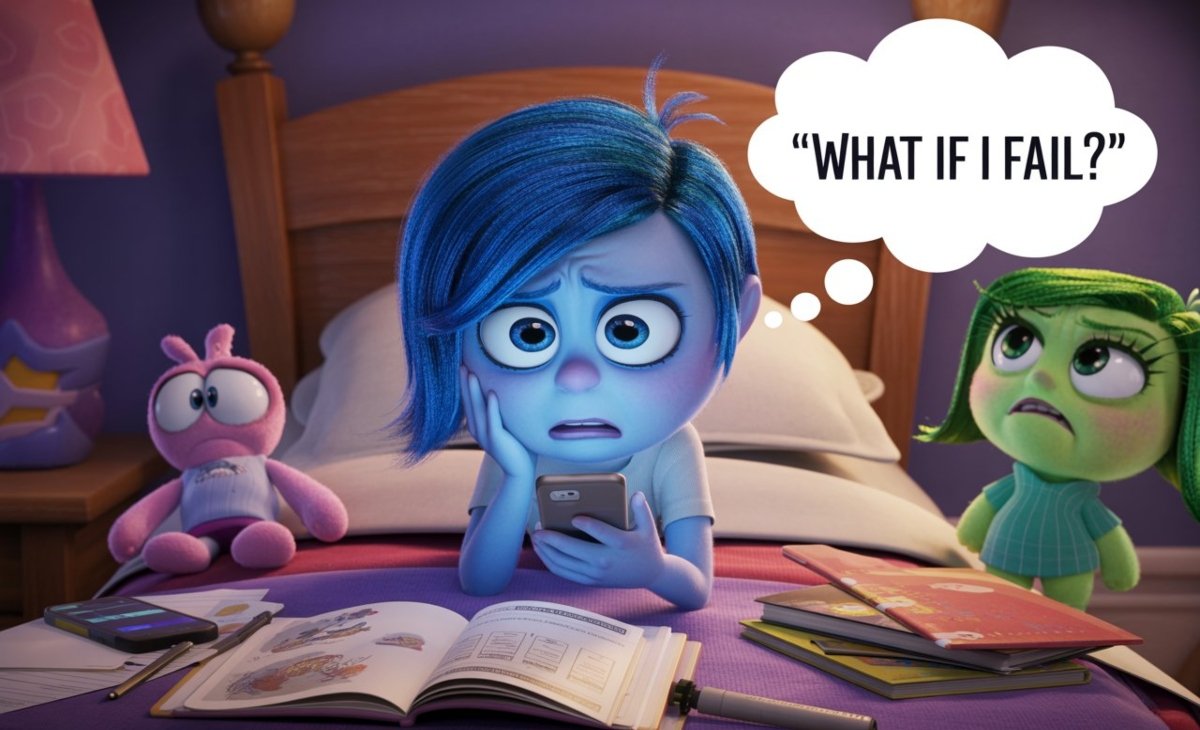There’s a moment in Pixar’s Inside Out 2 Glued to Phone that doesn’t rely on flashy visuals or fast-paced dialogue to land its punch. It’s subtle—quiet even—but deeply unsettling in its familiarity. Riley, now a preteen, faced with a rush of new emotions, social pressure, and internal chaos, doesn’t lash out or cry. She simply picks up her phone. And for a few minutes, everything else fades.
Dubbed by fans and psychologists alike as the “glued to phone” scene, this brief yet resonant sequence has sparked discussion across dinner tables, therapy sessions, and educator panels. It’s not just about technology—it’s about emotional avoidance. About that terrifying moment when a young person retreats behind a screen, not to be rebellious or rude, but to escape the complexity of being alive.
And Pixar, with its usual emotional intelligence, doesn’t dramatize it. They just let it happen.
What Happens in the Scene
It’s a scene that unfolds without urgency. Riley has just experienced a triggering moment—maybe social rejection, maybe an emotional letdown—and instead of expressing sadness or frustration, she lowers her gaze and reaches instinctively for her phone. The lighting around her softens. The sounds in the room dim. Her posture slackens. Her face goes blank.
Inside her mind, things are less calm. Joy hesitates. Sadness steps back. A newly introduced emotion, Anxiety, starts pacing frantically. The control panel dims to a muted blue, symbolizing emotional shutdown. It’s as if Riley’s internal world has been temporarily unplugged.
Nothing dramatic happens—and that’s exactly why it hits so hard.
The Psychology of Digital Dissociation
For many viewers, the “glued to phone” moment wasn’t just storytelling. It was a mirror. It’s a familiar coping mechanism—one that’s rarely talked about, and almost never shown with such nuance in media aimed at families.
What Riley experiences is a psychological state known as dissociation. It’s a way for the mind to buffer itself from feelings it isn’t ready to face. In the past, this might have looked like zoning out, staring at a wall, or daydreaming. But today, the smartphone becomes the quickest gateway to disconnect.
And Pixar nails it—not by scolding, but by observing. They don’t make Riley’s behavior a plot device or a joke. Instead, they show how a glowing screen can become a wall between a child and their emotions.
A Moment That Reflects Modern Adolescence
Inside Out 2 understands something fundamental about growing up today: emotions aren’t just shaped by friends, family, or hormones anymore. They’re shaped by algorithms, notifications, and the constant option to opt out of discomfort.
The film doesn’t present technology as the enemy. It doesn’t blame the phone. It simply asks a question: What are kids running from when they run to their screens?
It’s a hauntingly honest question—one that resonates far beyond the movie theater.
Why This Scene Feels So Real
Parents recognize that blank stare. Teachers have seen the subtle withdrawal. And teens? They understand it intimately. Not as defiance. Not as laziness. But as a moment of relief.
That’s why this scene doesn’t need dramatic music or heightened stakes. It’s powerful because it’s true. And in its truth lies its relevance. Riley’s silence, her subtle drift into her phone, is a behavior that millions of families have witnessed firsthand—and sometimes participated in themselves.
Animation as Emotional Language
What makes this scene even more impactful is how Pixar tells the story visually. There’s no voiceover explaining what’s happening. There’s no dramatic narration or musical cue signaling trouble. Instead, we feel the change through slowed animation, muted tones, and micro-expressions.
Riley’s eyes lose their shine. The grip on her phone tightens ever so slightly. The emotional control panel dims—not off, but unresponsive. It’s a symphony of subtlety, communicating that something is deeply wrong, without saying a single word.
And in her mind, the emotions are just as helpless as the viewers. It’s a brilliant device that invites the audience to feel that same emotional powerlessness—and maybe, to reflect on what they do in similar moments.
How Viewers Are Responding
Since its release, Inside Out 2’s “glued to phone” moment has struck a nerve. Not because it’s shocking—but because it’s too familiar.
Parents have taken to social media to share stories of watching the film and seeing their child in Riley’s shoes. Therapists are praising the film for capturing dissociation with empathy instead of judgment. And educators are even using the scene as a conversation starter in classrooms and workshops.
One mom, interviewed after a community screening, said: “It wasn’t just my daughter I saw—it was me. I do that too. I check out when I can’t handle things. And the movie helped me realize how often I retreat behind a screen instead of reaching out.”
The Bigger Conversation: Tech, Emotion, and Avoidance
What Inside Out 2 achieves, perhaps better than any other animated film to date, is to acknowledge that technology is not evil—but it’s powerful. And when used as a shield rather than a tool, it can stall emotional growth.
In Riley’s case, her phone isn’t a toy. It’s an escape hatch. And while that might seem harmless on the surface, the consequences are internalized. Emotional responses get buried. Self-reflection is delayed. Vulnerability is replaced with distraction.
And the scene doesn’t try to solve it. It just presents it. And in doing so, it encourages families, teachers, and young viewers to start the dialogue themselves.
What It Means For Families Watching Together
For parents watching with their kids, this scene offers an opportunity—not to preach, but to ask.
What do you feel when you reach for your phone?
Is it boredom? Sadness? Stress?
What could you say, instead of scroll?
These aren’t easy questions. But they’re important ones. Inside Out 2 Glued to Phone provides the perfect, non-threatening way to begin having them.
By not villainizing Riley or her choices, the film builds trust. And trust is what opens the door for real conversation.
Inside Out 2 Is Not Anti-Phone—It’s Pro-Feeling
Perhaps the most impressive part of the “glued to phone” moment is that it doesn’t carry a hidden agenda. Pixar’s not trying to spark a movement against smartphones. They’re not scaring kids away from their screens.
They’re saying: “Look. This is happening. Let’s understand it.”
It’s an approach rooted in empathy, not fear. And it might just be the best approach we’ve seen yet to addressing the emotional cost of digital life—especially for children learning how to navigate feelings in a world that doesn’t always slow down for them to feel.
Conclusion: Why This Scene Will Stay With Us
In the grand tradition of Pixar storytelling, the “glued to phone” scene isn’t flashy. It doesn’t end with a resolution. It doesn’t wrap up Riley’s feelings in a bow. But it lingers. And that’s its genius.
Because emotional detachment doesn’t happen in big moments—it happens quietly.
And that’s why this moment matters. It gives language to something so many of us experience but can’t explain. It opens doors to empathy. To understand. To heal.
Sometimes the loudest cry for help is the one that looks like nothing at all. And Pixar, once again, has found a way to show us the invisible—and ask us to feel it.
FAQs About Inside Out 2 Glued to Phone
What exactly happens in the “glued to phone” scene in Inside Out 2?
Riley, overwhelmed by emotion, retreats into her phone rather than facing her feelings. Her inner emotions observe in confusion as she disconnects. It’s a powerful visual metaphor for emotional avoidance.
Is Pixar criticizing smartphones in this scene?
No. Pixar presents technology as both a tool and a coping mechanism. The scene isn’t judgmental—it’s observational. It invites empathy, not blame.
How do Riley’s emotions react inside her mind?
Joy becomes silent. Sadness retreats. Anxiety panics. The emotional control panel dims, symbolizing Riley’s inner disconnection from her feelings.
Why did this scene resonate with so many viewers?
Because it reflects real-life behavior—especially in teens and adults who use screens to avoid discomfort. It’s familiar, subtle, and deeply emotional.
What can parents take away from this scene?
That screen time often masks emotional overload. The key isn’t to eliminate phones, but to ask why they’re being used—and what feelings might be going unspoken.


